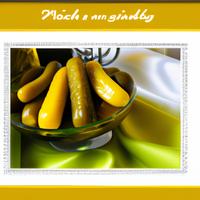
1 serving (30 grams) contains 4 calories, 0.1 grams of protein, 0.1 grams of fat, and 0.7 grams of carbohydrates.

Log this food in SnapCalorie

Nutrition Information
Calories |
28.8 | ||
|---|---|---|---|
% Daily Value* |
|||
| Total Fat | 0.5 g | 0% | |
| Saturated Fat | 0.2 g | 1% | |
| Polyunsaturated Fat | 0 g | ||
| Cholesterol | 0 mg | 0% | |
| Sodium | 2899.2 mg | 126% | |
| Total Carbohydrates | 5.8 g | 2% | |
| Dietary Fiber | 2.9 g | 10% | |
| Sugars | 2.6 g | ||
| protein | 1.2 g | 2% | |
| Vitamin D | 0 mcg | 0% | |
| Calcium | 33.6 mg | 2% | |
| Iron | 0.7 mg | 3% | |
| Potassium | 280.8 mg | 5% | |
* Percent Daily Values are based on a 2,000 calorie diet. Your daily values may be higher or lower depending on your calorie needs.
Food Attributes
Source of Calories
About Pickle cucumbers
Pickle cucumbers are crisp, small cucumbers cultivated specifically for pickling, a preservation process that enhances flavor and extends shelf life. Native to India, cucumbers spread across cuisines worldwide, with pickling becoming especially popular in Central and Eastern Europe. Packed with water and low in calories, pickle cucumbers are a hydrating snack rich in vitamins such as K and C, along with small amounts of potassium and magnesium. When pickled, they may also contain probiotics, supporting gut health. However, pickling often introduces high levels of sodium, which can be a concern for individuals monitoring their intake. Commonly used in sandwiches, salads, or as a tangy side dish, pickle cucumbers bring texture and zest to meals. Whether raw or jarred, they offer a refreshing and versatile addition to various recipes.



